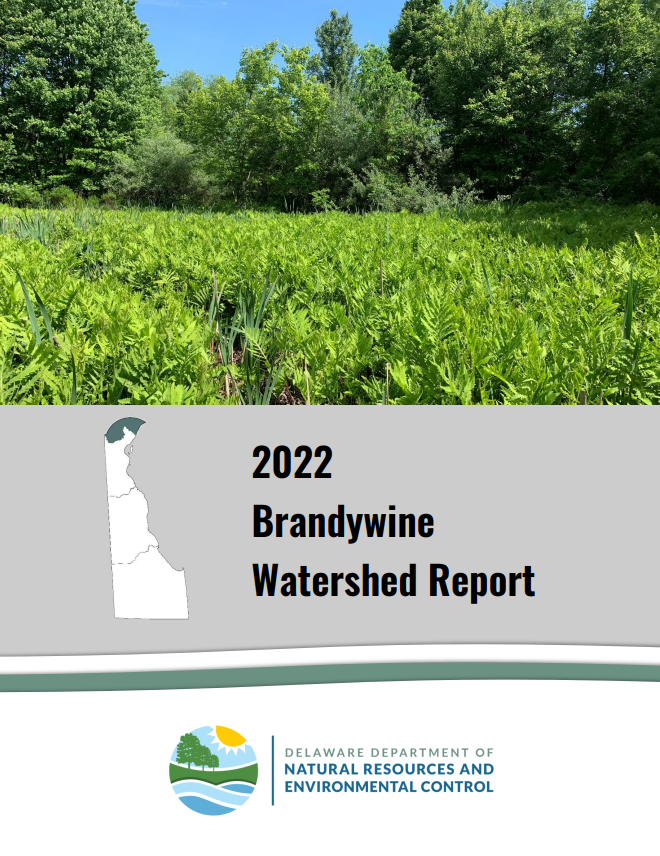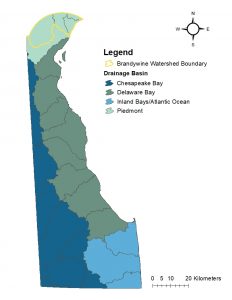DNREC Brandywine Watershed Report Details Wetland Health and Management Recommendations
Department of Natural Resources and Environmental Control | Division of Watershed Stewardship | Newsroom | Date Posted: Thursday, June 23, 2022
Department of Natural Resources and Environmental Control | Division of Watershed Stewardship | Newsroom | Date Posted: Thursday, June 23, 2022

The Delaware Department of Natural Resources and Environmental Control has released a report and educational report card on the health of wetlands within Delaware’s portion of the Brandywine watershed, with wetlands earning a C+ grade with recommendations for improvement. Published by the DNREC Wetland Monitoring and Assessment Program (WMAP), the report covers the Brandywine watershed, a combination of eight sub-watersheds. The Delaware part of the watershed resides in New Castle County, where it encompasses 72,969 acres (114 square miles) of land.
This northernmost watershed in Delaware is part of the Piedmont region and extends farther north into Pennsylvania. During the summer of 2019, environmental scientists from the DNREC Division of Watershed Stewardship collected data on the plants, hydrology and wetland buffer disturbances from 68 random sites within the Brandywine watershed. Using wetland stressor checklists and biological metrics, they determined the wetlands in the watershed to be in moderate condition, falling in the lower end of Delaware watersheds previously rated by DNREC. The WMAP scientists found the most common stressors to the Brandywine were fill, structures interrupting waterflow, and invasive species, development, roads and mowing in the surrounding landscape. More details about DNREC wetland health assessments can be found at de.gov/watershedhealth.
The report found approximately 3% of the land area of the Brandywine watershed is currently covered by wetlands. WMAP performed freshwater assessments in 14 flat wetlands, 24 riverine wetlands, 11 depression wetlands, and 19 seep wetlands using the Delaware Rapid Assessment Procedure (DERAP) Version 6.0, a data collection method created by DNREC environmental scientists, which is now available for use by professionals and the public. No tidal wetlands were assessed because there were very few tidal wetlands in the watershed, and those that were present occurred only in a couple of small areas. The watershed also contained some Category One wetlands, which are rare, unique, freshwater wetland types in Delaware.
DNREC’s data was used to create a technical report and a more user-friendly “watershed report card.” The technical report summarizes not only the health of the Brandywine watershed’s wetlands, but also examined the change in wetland acreage in recent decades; what value the wetlands provide; and how recent changes in land use will impact wetlands in the future. The report card condenses general information on the watershed, summarizes environmental indicators of wetland health, and showcases what the general public can do to help the future of the Brandywine watershed’s wetlands.

Mapping analysis estimated that by 2017, 26% of historic wetland acreage in the watershed had been lost, mostly due to human impacts such as development. On-the-ground assessments were used rate the health and function of remaining wetlands. Impacts to wetland health reduce a wetland’s ability to perform fully, diminishing its valuable role in controlling flooding and erosion; improving water quality; storing excess rainwater; and providing ecosystem services for both people and wildlife. In this watershed, wetlands overall received a C+ grade. Forested flats and groundwater seep wetland types received a class grade of B-, while riverine and depressions both received C grades, based on impacts mostly to the buffer habitat surrounding wetlands.
Based on the results of this study, DNREC made recommendations targeting scientists, public decision makers and landowners toward improving and enhancing the future health of Delaware’s wetlands. These recommendations included maintaining adequate wetland buffers, restoration activities, increasing education and outreach, using best management practices, suggesting that landowners protect wetlands on their property, and improving the protection of the watershed’s non-tidal wetlands for the future.
The DNREC Wetland Monitoring and Assessment Program, funded by the U.S. EPA’s Region 3 Wetland Program Development grants, prepares wetland health reports for Delaware watersheds. Those reports, including the report for the Brandywine watershed, are found at de.gov/watershedhealth.
About DNREC
The Delaware Department of Natural Resources and Environmental Control protects and manages the state’s natural resources, protects public health, provides outdoor recreational opportunities and educates Delawareans about the environment. The DNREC Division of Watershed Stewardship develops and implements innovative watershed assessment, monitoring and implementation activities. For more information, visit the website and connect with @DelawareDNREC on Facebook, Twitter or LinkedIn.
Media Contacts: Joanna Wilson, joanna.wilson@delaware.gov; Michael Globetti, michael.globetti@delaware.gov
Keep up to date by receiving a daily digest email, around noon, of current news release posts from state agencies on news.delaware.gov.
Here you can subscribe to future news updates.
Department of Natural Resources and Environmental Control | Division of Watershed Stewardship | Newsroom | Date Posted: Thursday, June 23, 2022

The Delaware Department of Natural Resources and Environmental Control has released a report and educational report card on the health of wetlands within Delaware’s portion of the Brandywine watershed, with wetlands earning a C+ grade with recommendations for improvement. Published by the DNREC Wetland Monitoring and Assessment Program (WMAP), the report covers the Brandywine watershed, a combination of eight sub-watersheds. The Delaware part of the watershed resides in New Castle County, where it encompasses 72,969 acres (114 square miles) of land.
This northernmost watershed in Delaware is part of the Piedmont region and extends farther north into Pennsylvania. During the summer of 2019, environmental scientists from the DNREC Division of Watershed Stewardship collected data on the plants, hydrology and wetland buffer disturbances from 68 random sites within the Brandywine watershed. Using wetland stressor checklists and biological metrics, they determined the wetlands in the watershed to be in moderate condition, falling in the lower end of Delaware watersheds previously rated by DNREC. The WMAP scientists found the most common stressors to the Brandywine were fill, structures interrupting waterflow, and invasive species, development, roads and mowing in the surrounding landscape. More details about DNREC wetland health assessments can be found at de.gov/watershedhealth.
The report found approximately 3% of the land area of the Brandywine watershed is currently covered by wetlands. WMAP performed freshwater assessments in 14 flat wetlands, 24 riverine wetlands, 11 depression wetlands, and 19 seep wetlands using the Delaware Rapid Assessment Procedure (DERAP) Version 6.0, a data collection method created by DNREC environmental scientists, which is now available for use by professionals and the public. No tidal wetlands were assessed because there were very few tidal wetlands in the watershed, and those that were present occurred only in a couple of small areas. The watershed also contained some Category One wetlands, which are rare, unique, freshwater wetland types in Delaware.
DNREC’s data was used to create a technical report and a more user-friendly “watershed report card.” The technical report summarizes not only the health of the Brandywine watershed’s wetlands, but also examined the change in wetland acreage in recent decades; what value the wetlands provide; and how recent changes in land use will impact wetlands in the future. The report card condenses general information on the watershed, summarizes environmental indicators of wetland health, and showcases what the general public can do to help the future of the Brandywine watershed’s wetlands.

Mapping analysis estimated that by 2017, 26% of historic wetland acreage in the watershed had been lost, mostly due to human impacts such as development. On-the-ground assessments were used rate the health and function of remaining wetlands. Impacts to wetland health reduce a wetland’s ability to perform fully, diminishing its valuable role in controlling flooding and erosion; improving water quality; storing excess rainwater; and providing ecosystem services for both people and wildlife. In this watershed, wetlands overall received a C+ grade. Forested flats and groundwater seep wetland types received a class grade of B-, while riverine and depressions both received C grades, based on impacts mostly to the buffer habitat surrounding wetlands.
Based on the results of this study, DNREC made recommendations targeting scientists, public decision makers and landowners toward improving and enhancing the future health of Delaware’s wetlands. These recommendations included maintaining adequate wetland buffers, restoration activities, increasing education and outreach, using best management practices, suggesting that landowners protect wetlands on their property, and improving the protection of the watershed’s non-tidal wetlands for the future.
The DNREC Wetland Monitoring and Assessment Program, funded by the U.S. EPA’s Region 3 Wetland Program Development grants, prepares wetland health reports for Delaware watersheds. Those reports, including the report for the Brandywine watershed, are found at de.gov/watershedhealth.
About DNREC
The Delaware Department of Natural Resources and Environmental Control protects and manages the state’s natural resources, protects public health, provides outdoor recreational opportunities and educates Delawareans about the environment. The DNREC Division of Watershed Stewardship develops and implements innovative watershed assessment, monitoring and implementation activities. For more information, visit the website and connect with @DelawareDNREC on Facebook, Twitter or LinkedIn.
Media Contacts: Joanna Wilson, joanna.wilson@delaware.gov; Michael Globetti, michael.globetti@delaware.gov
Keep up to date by receiving a daily digest email, around noon, of current news release posts from state agencies on news.delaware.gov.
Here you can subscribe to future news updates.